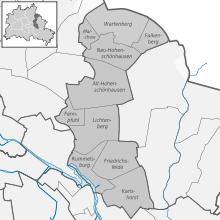Lichtenberg
| Lichtenberg | ||
|---|---|---|
| Borough of Berlin | ||
| ||
 Lichtenberg | ||
Location of Lichtenberg in Berlin .svg.png) | ||
| Coordinates: 52°32′N 13°30′E / 52.533°N 13.500°ECoordinates: 52°32′N 13°30′E / 52.533°N 13.500°E | ||
| Country | Germany | |
| State | Berlin | |
| City | Berlin | |
| Government | ||
| • Mayor | Birgit Monteiro (SPD) | |
| Area | ||
| • Total | 52.30 km2 (20.19 sq mi) | |
| Population (2012-11-30) | ||
| • Total | 268,466 | |
| • Density | 5,100/km2 (13,000/sq mi) | |
| Time zone | CET/CEST (UTC+1/+2) | |
| Vehicle registration | B | |
| Website | Official homepage | |
Lichtenberg is the eleventh borough of Berlin, Germany. In Berlin's 2001 administrative reform it absorbed the former borough of Hohenschönhausen.
Overview
The district contains the Tierpark Berlin in Friedrichsfelde, the larger of Berlin's two zoological gardens. Lichtenberg was also the site of the extensive headquarters complex of the Stasi, the East German intelligence service. Prior to the establishment of the GDR it housed the main office of the Soviet Military Administration in Berlin, and before that it was an officers' mess of the Wehrmacht. The complex is now the location of the Stasi Museum. The Berlin-Hohenschönhausen Memorial is on the site of the main remand prison of the Stasi. Lichtenberg is also the location of the German-Russian Museum, the historical venue of the unconditional surrender of the German armed forces (Wehrmacht) on 8 May 1945.
Subdivision

Lichtenberg is divided into 10 localities:
| Locality |
Area (km²) |
Inhabitants 30 June 2008 |
Density (inhabitants/km²) |
| 1101 Friedrichsfelde |
5.8 | 50,010 | 8,622 |
| 1102 Karlshorst |
6.6 | 21,057 | 3,190 |
| 1103 Lichtenberg |
7.33 | 32,295 | 4,406 |
| 1104 Falkenberg |
3.0 | 1,164 | 388 |
| 1106 Malchow |
3.0 | 450 | 150 |
| 1107 Wartenberg |
5.31 | 2,433 | 458 |
| 1109 Neu-Hohenschönhausen |
5.32 | 53,698 | 10,094 |
| 1110 Alt-Hohenschönhausen |
10.0 | 41,780 | 4,178 |
| 1111 Fennpfuhl |
1.75 | 30,932 | 17,675 |
| 1112 Rummelsburg |
4.16 | 17,567 | 4,223 |
History
The historic village of Lichtenberg together with neighbouring Friedrichsfelde, Karlshorst, Marzahn, Biesdorf, Hellersdorf, Kaulsdorf and Mahlsdorf was incorporated as the 17th borough of Berlin by the 1920 Greater Berlin Act.
In the 1970s the East German government had large pre-fabricated high-rise housing estates (Plattenbau) built in the east of the Lichtenberg borough. This area was separated off and became the new borough of Marzahn, which included Biesdorf, Hellersdorf, Kaulsdorf and Mahlsdorf in 1979. In 1986 this district in turn was split into the two boroughs of Marzahn and Hellersdorf in 1986, and again merged as Marzahn-Hellersdorf by the 2001 administrative reform.
Berlin's Asiatown in the East
Lichtenberg is a developing center of Asian culture and dubbed the eastern Asiatown or Chinatown of Berlin. The Dong Xuan Center around Herzbergstrasse on former industrial grounds is a development quarter with many different Asian businesses, various shops, food producers and wholesalers/distributors, residential areas and cultural offers.[1]
Politics
.svg.png)
At the 2011 elections for the parliament of the borough (Bezirksverordnetenversammlung) the following parties were elected:
- The Left 20
- SPD 17
- CDU 7
- Pirate Party 5
- Alliance '90/The Greens 4
- NPD 2
Twin towns
The Lichtenberg borough has five twin towns:
 5. district, Maputo, Mozambique since 1995
5. district, Maputo, Mozambique since 1995 Białołęka, Warsaw, Poland since 2000
Białołęka, Warsaw, Poland since 2000 Kaliningrad, Russia since 2001
Kaliningrad, Russia since 2001 Hajnówka County, Poland since 2001
Hajnówka County, Poland since 2001 Jurbarkas district municipality, Lithuania since 2003
Jurbarkas district municipality, Lithuania since 2003
See also
References
External links
| Wikimedia Commons has media related to Lichtenberg. |
 "Lichtenberg". New International Encyclopedia. 1905.
"Lichtenberg". New International Encyclopedia. 1905. "Lichtenberg". Encyclopædia Britannica (11th ed.). 1911.
"Lichtenberg". Encyclopædia Britannica (11th ed.). 1911.- Official homepage
- Official homepage of Berlin
- Event- und Informationportal of Berlin Lichtenberg

